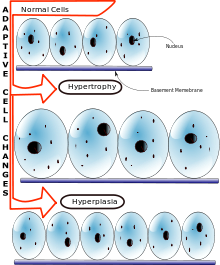Hypertrophy
This articleneeds morereliable medical referencesforverificationor relies too heavily onprimary sources.(May 2017) |  |
| Hypertrophy | |
|---|---|
 | |
| Hypertrophy results from an increase in cell size, whereashyperplasiastems from an increase in cell number. |
Hypertrophyis the increase in the volume of an organ or tissue due to the enlargement of its componentcells.[1]It is distinguished fromhyperplasia,in which the cells remain approximately the same size but increase in number.[2]Although hypertrophy and hyperplasia are two distinct processes, they frequently occur together, such as in the case of thehormonallyinduced proliferation and enlargement of the cells of theuterusduringpregnancy.
Eccentric hypertrophyis a type of hypertrophy where the walls and chamber of a hollow organ undergo growth in which the overall size and volume are enlarged. It is applied especially to theleft ventricleof heart.[3]Sarcomeresare added in series, as for example indilated cardiomyopathy(in contrast tohypertrophic cardiomyopathy,a type ofconcentric hypertrophy,where sarcomeres are added in parallel).
Gallery
[edit]| -plasia and -trophy |
|---|
|
|
See also
[edit]- Athlete's heart
- Ventricular hypertrophy(includingleft ventricular hypertrophyandright ventricular hypertrophy)
- Muscle hypertrophy
- List of biological development disorders
References
[edit]- ^Hernandez, Richard; Kravitz, Len."Skeletal muscle hypertrophy".www.unm.edu.
- ^"Hyperplasia: MedlinePlus Medical Encyclopedia".medlineplus.gov.Retrieved2023-02-19.
- ^Kusumoto, F. M. (2004),Cardiovascular Pathophysiology,Hayes Barton Press, pp. 20–22,ISBN978-1-59377-189-8












